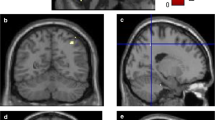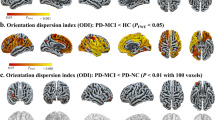Abstract
Mild cognitive impairment (MCI) in Parkinson’s disease (PD) is a risk factor for dementia and thus, it is of interest to elucidate if specific patterns of atrophy in PD-MCI patients are associated with a higher risk of developing dementia. We aim to define pattern(s) of regional atrophy in PD-MCI patients who developed dementia during 31 months of follow-up using cortical thickness analysis Twenty-three PD-MCI patients and 18 controls underwent brain MRI and completed a neuropsychological examination at baseline, PD-MCI patients were followed after a 31 month follow-up in order to assess their progression to dementia. At follow up, 8 PD-MCI patients had converted to dementia (PD-MCI converters) whereas 15 remained as PD-MCI (PD-MCI non-converters). All patients were at least 60 years old and suffered PD ≥ 10 years. There were no baseline differences between the two groups of patients in clinical and neuropsychological variables. The cortex of PD-MCI converters was thinner than that of PD-MCI non-converters, bilaterally in the frontal, insula and the left middle temporal areas, also displaying a more widespread pattern of cortical thinning relative to the controls. This study shows that aged and long-term PD patients with MCI who convert to dementia in the short-mid term suffer a thinning of the cortex in several areas (frontal cortex, and middle temporal lobe and insula), even when their cognitive impairment was similar to that of PD-MCI non-converters. Thus, MRI analysis of cortical thickness may represent a useful measure to identify PD-MCI patients at a higher risk of developing dementia.

Similar content being viewed by others
References
Aarsland, D., Zaccai, J., & Brayne, C. (2005). A systematic review of prevalence studies of dementia in Parkinson's disease. Movement Disorders, 20(10), 1255–1263.
Aarsland, D., Bronnick, K., Williams-Gray, C., Weintraub, D., Marder, K., et al. (2010). Mild cognitive impairment in Parkinson disease: A multicenter pooled analysis. Neurology, 75(12), 1062–1069.
Broeders, M., de Bie, R. M., Velseboer, D. C., Speelman, J. D., Muslimovic, D., et al. (2013). Evolution of mild cognitive impairment in Parkinson disease. Neurology, 81(4), 346–352.
Compta, Y., Pereira, J. B., Rios, J., Ibarretxe-Bilbao, N., Junque, C., et al. (2013). Combined dementia-risk biomarkers in Parkinson's disease: A prospective longitudinal study. Parkinsonism & Related Disorders, 19(8), 717–724.
Dale, A. M., & Sereno, M. I. (1993). Improved localization of cortical activity by combining EEG and MEG with MRI cortical surface reconstruction: A linear approach. Journal of Cognitive Neuroscience, 5(2), 162–176.
Dale, A. M., Fischl, B., & Sereno, M. I. (1999). Cortical surface-based analysis. I. Segmentation and surface reconstruction. NeuroImage, 9(2), 179–194.
Desikan, R. S., Segonne, F., Fischl, B., Quinn, B. T., Dickerson, B. C., et al. (2006). An automated labeling system for subdividing the human cerebral cortex on MRI scans into gyral based regions of interest. NeuroImage, 31(3), 968–980.
Du, A. T., Schuff, N., Kramer, J. H., Rosen, H. J., Gorno-Tempini, M. L., et al. (2007). Different regional patterns of cortical thinning in Alzheimer's disease and frontotemporal dementia. Brain, 130(Pt 4), 1159–1166.
Emre, M., Aarsland, D., Brown, R., Burn, D. J., Duyckaerts, C., et al. (2007). Clinical diagnostic criteria for dementia associated with Parkinson's disease. Movement Disorders, 22(12), 1689–1707 quiz 837.
Fischl, B., & Dale, A. M. (2000). Measuring the thickness of the human cerebral cortex from magnetic resonance images. Proceedings of the National Academy of Sciences of the United States of America, 97(20), 11050–11055.
Fischl, B., Sereno, M. I., & Dale, A. M. (1999a). Cortical surface-based analysis. II: Inflation, flattening, and a surface-based coordinate system. NeuroImage, 9(2), 195–207.
Fischl, B., Sereno, M. I., Tootell, R. B., & Dale, A. M. (1999b). High-resolution intersubject averaging and a coordinate system for the cortical surface. Human Brain Mapping, 8(4), 272–284.
Fischl, B., Salat, D. H., Busa, E., Albert, M., Dieterich, M., et al. (2002). Whole brain segmentation: Automated labeling of neuroanatomical structures in the human brain. Neuron, 33(3), 341–355.
Fischl, B., van der Kouwe, A., Destrieux, C., Halgren, E., Segonne, F., et al. (2004). Automatically parcellating the human cerebral cortex. Cerebral Cortex, 14(1), 11–22.
Garcia-Garcia, D., Clavero, P., Gasca Salas, C., Lamet, I., Arbizu, J., et al. (2012). Posterior parietooccipital hypometabolism may differentiate mild cognitive impairment from dementia in Parkinson’s disease. European Journal of Nuclear Medicine and Molecular Imaging, 39, 1767–1777.
Gasca-Salas, C., Estanga, A., Clavero, P., Aguilar-Palacio, I., Gonzalez-Redondo, R., et al. (2014). Longitudinal assessment of the pattern of cognitive decline in non-demented patients with advanced Parkinson's disease. Journal of Parkinsons Disease, 4(4), 677–686.
Gonzalez-Redondo, R., Garcia-Garcia, D., Clavero, P., Gasca-Salas, C., Garcia-Eulate, R., et al. (2014). Grey matter hypometabolism and atrophy in Parkinson’s disease with cognitive impairment: A two-step process. Brain, 137, 2356–2367.
Gutierrez-Galve, L., Lehmann, M., Hobbs, N. Z., Clarkson, M. J., Ridgway, G. R., et al. (2009). Patterns of cortical thickness according to APOE genotype in Alzheimer's disease. Dementia and Geriatric Cognitive Disorders, 28(5), 476–485.
Hely, M. A., Reid, W. G., Adena, M. A., Halliday, G. M., & Morris, J. G. (2008). The Sydney multicenter study of Parkinson's disease: The inevitability of dementia at 20 years. Movement Disorders, 23(6), 837–844.
Hughes, A. J., Daniel, S. E., Kilford, L., & Lees, A. J. (1992). Accuracy of clin- ical diagnosis of idiopathic Parkinson’s disease: A clinico- pathological study of 100 cases. Journal of Neurology, Neurosurgery, and Psychiatry, 55, 181–184.
Janvin, C. C., Larsen, J. P., Aarsland, D., & Hugdahl, K. (2006). Subtypes of mild cognitive impairment in Parkinson's disease: Progression to dementia. Movement Disorders, 21(9), 1343–1349.
Kandiah, N., Zainal, N. H., Narasimhalu, K., Chander, R. J., Ng, A., et al. (2014). Hippocampal volume and white matter disease in the prediction of dementia in Parkinson's disease. Parkinsonism & Related Disorders, 20(11), 1203–1208.
Lee, J. E., Cho, K. H., Song, S. K., Kim, H. J., Lee, H. S., et al. (2014). Exploratory analysis of neuropsychological and neuroanatomical correlates of progressive mild cognitive impairment in Parkinson's disease. Journal of Neurology, Neurosurgery, and Psychiatry, 85(1), 7–16.
Litvan, I., Aarsland, D., Adler, C. H., Goldman, J. G., Kulisevsky, J., et al. (2011). MDS task force on mild cognitive impairment in Parkinson's disease: Critical review of PD-MCI. Movement Disorders, 26(10), 1814–1824.
Litvan, I., Goldman, J. G., Troster, A. I., Schmand, B. A., Weintraub. D., et al. (2012). Diagnostic criteria for mild cognitive impairment in Parkinson’s disease: Movement Disorder Society Task Force guidelines. Movement Disorders, 27(3), 349–356.
Mak, E., Su, L., Williams, G. B., Firbank, M. J., Lawson, R. A., et al. (2015). Baseline and longitudinal grey matter changes in newly diagnosed Parkinson's disease: ICICLE-PD study. Brain, 138(Pt 10), 2974–2986.
Pagonabarraga, J., Corcuera-Solano, I., Vives-Gilabert, Y., Llebaria, G., García-Sánchez, C., et al. (2013). Pattern of regional cortical thinning associated with cognitive deterioration in Parkinson's disease. PloS One, 8(1), e54980.
Pedersen, K. F., Larsen, J. P., Tysnes, O. B., & Alves, G. (2013). Prognosis of mild cognitive impairment in early Parkinson disease: The Norwegian ParkWest study. JAMA Neurology, 70(5), 580–586.
Pereira, J. B., Ibarretxe-Bilbao, N., Marti, M. J., Compta, Y., Junque, C., et al. (2014a). Assessment of cortical degeneration in patients with Parkinson’s disease by voxel-based morphometry, cortical folding, and cortical thickness. Human Brain Mapping, 33(11), 2521–2534.
Pereira, J. B., Svenningsson, P., Weintraub, D., Brønnick, K, Lebedev, A., et al. (2014b). Initial cognitive decline is associated with cortical thinning in early Parkinson disease. Neurology, 82(22), 2017–2025.
Rahayel, S., Montplaisir, J., Monchi, O., Bedetti, C., Postuma, R. B., Brambati, S., et al. (2015). Patterns of cortical thinning in idiopathic rapid eye movement sleep behavior disorder. Movement Disorders, 30(5), 680–687.
Reuter, M., Rosas, H. D., & Fischl, B. (2010). Highly accurate inverse consistent registration: A robust approach. NeuroImage, 53(4), 1181–1196.
Segonne, F., Dale, A. M., Busa, E., Glessner, M., Salat, D., et al. (2004). A hybrid approach to the skull stripping problem in MRI. NeuroImage, 22(3), 1060–1075.
Segura, B., Baggio, H.C., Marti, M.J, Valldeoriola, F., Compta, Y., et al. (2014). Cortical thinning associated with mild cognitive impairment in Parkinson's disease. Movement Disorders, 29(12), 1495–1503.
Sled, J. G., Zijdenbos, A. P., & Evans, A. C. (1998). A nonparametric method for automatic correction of intensity nonuniformity in MRI data. IEEE Transactions on Medical Imaging, 17(1), 87–97.
Song, S. K., Lee, J. E., Park, H. J., Sohn, Y. H., Lee, J., & Lee, P. H. (2011). The pattern of cortical atrophy in patients with Parkinson's disease according to cognitive status. Movement Disorders, 26(2), 289–296.
Teunisse, S., & Derix, M. M. (1997). The interview for deterioration in daily living activities in dementia: Agreement between primary and secondary caregivers. International Psychogeriatrics, 9(Suppl 1), 155–162.
Weston, P. S., Nicholas, J. M., Lehmann, M., Ryan, N. S., Liang, Y., Macpherson, K., et al. (2016). Presymptomatic cortical thinning in familial Alzheimer disease. Neurology, 87(19), 2050–2057.
Author information
Authors and Affiliations
Corresponding author
Ethics declarations
Funding
This study was supported by a grant from the Government of Navarre (32/2007), grants from the FIS (ISCIII: PI08/1539 y PI14/00763) and by CIBERNED (Spain).
Conflict of interest
Author Carmen Gasca-Salas received honoraria from UCB and TEVA for travel and accommodation to attend scientific meetings.
Author Daniel García-Lorenzo declares that he has no conflict of interest.
Author David García-García declares that he has no conflict of interest.
Author Pedro Clavero has received honoraria for lectures, travel and accommodation to attend scientific meetings from AbbVie, UCB and Esteve.
Author Stephan Lehericy has received honoraria for lectures from Pileje, Lundbeck, Roche and Siemens.
Author José A. Obeso has received honorarium for lecturing in meetings organized by GSK, Lundbeck and UCB in Spain; TEVA-Neuroscience (USA); Boehringer Ingelheim Mexico and funding from Spanish Science and Education Ministery and European Union (REPLACES).
Author María C. Rodríguez-Oroz received honoraria for lectures, travel and accommodation to attend scientific meetings from AbbVie, Teva, Zambon and Boston Scientific.
Ethical approval
All procedures performed in studies involving human participants were in accordance with the ethical standards of the institutional research committee and with the 1964 Helsinki declaration and its later amendments or comparable ethical standards. Informed consent was obtained from all individual participants included in the study.
Electronic supplementary material
ESM 1
Supplementary figure. Reduced regional cortical thickness in PD-MCI patients compared to healthy controls. (A) PD-MCI converters < controls (FDR, p < 0.05: age and sex as covariates). PD-MCI converters showed thinner cortex in the frontal cortex (mainly superior and medial frontal and precentral cortex), right insula and parietal cortex (superior parietal, supramarginal and inferior parietal on the left side and bilateral precuneus), left superior temporal and left isthmus cingulate. (B)PD-MCI non-converters < controls (FDR, p < 0.05: age and sex as covariates). PD-MCI non-converters showed thinner cortex than controls in the left side, in the frontal (mainly superior and precentral cortex), parietal (superior and supramarginal) and to a lesser extent in the temporal cortex. (PDF 4909 kb)
Rights and permissions
About this article
Cite this article
Gasca-Salas, C., García-Lorenzo, D., Garcia-Garcia, D. et al. Parkinson’s disease with mild cognitive impairment: severe cortical thinning antedates dementia. Brain Imaging and Behavior 13, 180–188 (2019). https://doi.org/10.1007/s11682-017-9751-6
Published:
Issue Date:
DOI: https://doi.org/10.1007/s11682-017-9751-6




